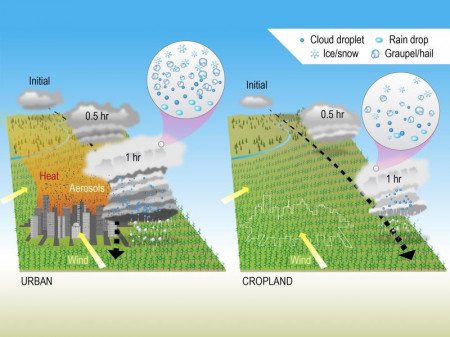How Urbanization and Pollution Increase Storm Activity Around Cities
Using NERSC’s Cori system, PNNL researchers modeled the effects of urban land and aerosols on storm patterns
March 9, 2021
Contact: cscomms@lbl.gov

This infographic depicts how a storm propagates when near a city versus when passing through cropland. The presence of buildings, heat and human-made aerosols can steer storms toward cities and intensify hazardous weather like hail. (Credit: Nathan Johnson, Pacific Northwest National Laboratory)
Walking through the heart of New York City on a bright summer day, heat reflecting off metal skyscrapers and emanating from the streets and sidewalks, urbanization feels hot and sweaty. But heat generated by urban land use can also influence stormy weather, bringing more severe storm activity toward highly developed cities.
A study led by scientists at Pacific Northwest National Laboratory (PNNL) used computing resources at the National Energy Research Scientific Computing Center (NERSC) to run detailed simulations of storm physics and found that urbanization, combined with human-produced (anthropogenic) aerosol air pollution, increased both storm strength and storm development in two major U.S. cities. The study uniquely considered the joint impact of urban land and aerosols together on storm developments.
“NERSC resources played a vital role in this study,” said the lead author, PNNL atmospheric scientist Jiwen Fan, who presented the team’s findings in December 2020 at the American Geophysical Union’s annual Fall Meeting; a related paper was published in Atmospheric Chemistry and Physics in November 2020. “We ran very computationally expensive models.”
Working with the chemistry version of the Weather Research and Forecasting model - in which the spectral-bin microphysics is coupled with the model for Simulating Aerosol Interactions and Chemistry at cloud-resolving scale (1 km) - the researchers used NERSC’s Cori system to study two separate convective storms: a supercell near Kansas City, Missouri that produced hail, tornado, and strong wind; and a sea-breeze-induced thunderstorm occurring near Houston, Texas.
They found that urbanization - the joint effect of both urban land and anthropogenic aerosols - notably enhanced storm and precipitation intensity. Urban land modifies convective evolution, speeding up cloud state transitions and initiating surface rain earlier, all of which results from urban heating-induced stronger sea-breeze circulation. The anthropogenic aerosol effect became evident after the storm clouds evolved, accelerating convective intensity and precipitation mainly by activating numerous ultrafine particles at various cloud stages.
Resolving Convection Patterns
To resolve convection patterns, a key part of the study, Fan and her team had to run their simulations at very high resolution. With this resolution, researchers were able to gain a good understanding of how physical factors affect storms.
“Convection updraft motions change very quickly; we output every five minutes, which produces a huge amount of data,” Fan said. “To be able to analyze our data we needed a lot of storage, and I really appreciated that NERSC was flexible when we needed more data space.” Fan’s team worked with NERSC consultants to determine how to best use the center’s data systems, resulting in NERSC providing 50 TB of storage on Cori’s high-speed scratch file system.
The two storms modeled in this study were very different, and the findings showed the distinct effects that urban land and aerosols had on each. In Kansas City, these effects divert the storm toward the city, amplifying the frequency of large hail by about 20 percent. In Houston, the most significant effect was the more intense and lengthy rainfall that developed more quickly. These effects were not present when the researchers ran the simulations without the cities’ parameters included.
Aerosol concentrations were particularly interesting in how they affected storms differently in each city, Fan noted. In Houston, the ultrafine aerosol particles present do not contribute much to the overall aerosol mass, but they occur in high numbers and activate in the strong convective clouds associated with storms, she explained. In addition, because Houston is especially humid, the aerosols have a “supersaturation” effect in which the small particles then become droplets. Because of their high numbers, more water vapor was converted into condensates during the Houston thunderstorm.
“In Kansas City, it’s a different story,” Fan said - in part because the aerosols in Kansas City came primarily from agricultural pollution surrounding the city. “The storm we were looking at, which is common to that city, was a supercell with rotating upward motions. It was in a high background aerosol condition and the city did not produce as many aerosols as in Houston. Thus the aerosol effect is small and the urban land effect is dominant, which even pulls the storm toward the city.”
This work illustrates the importance of considering both the urban land and anthropogenic aerosol effects for understanding urbanization effects on convective clouds and precipitation, the researchers concluded. They are now working on doing more predictive modeling, with the goal of being able to foresee hazardous weather and prevent death and damages from severe storms.
NERSC is a U.S. Department of Energy Office of Science user facility.
This article utilizes materials from a PNNL science highlight.
About NERSC and Berkeley Lab
The National Energy Research Scientific Computing Center (NERSC) is a U.S. Department of Energy Office of Science User Facility that serves as the primary high performance computing center for scientific research sponsored by the Office of Science. Located at Lawrence Berkeley National Laboratory, NERSC serves almost 10,000 scientists at national laboratories and universities researching a wide range of problems in climate, fusion energy, materials science, physics, chemistry, computational biology, and other disciplines. Berkeley Lab is a DOE national laboratory located in Berkeley, California. It conducts unclassified scientific research and is managed by the University of California for the U.S. Department of Energy. »Learn more about computing sciences at Berkeley Lab.







